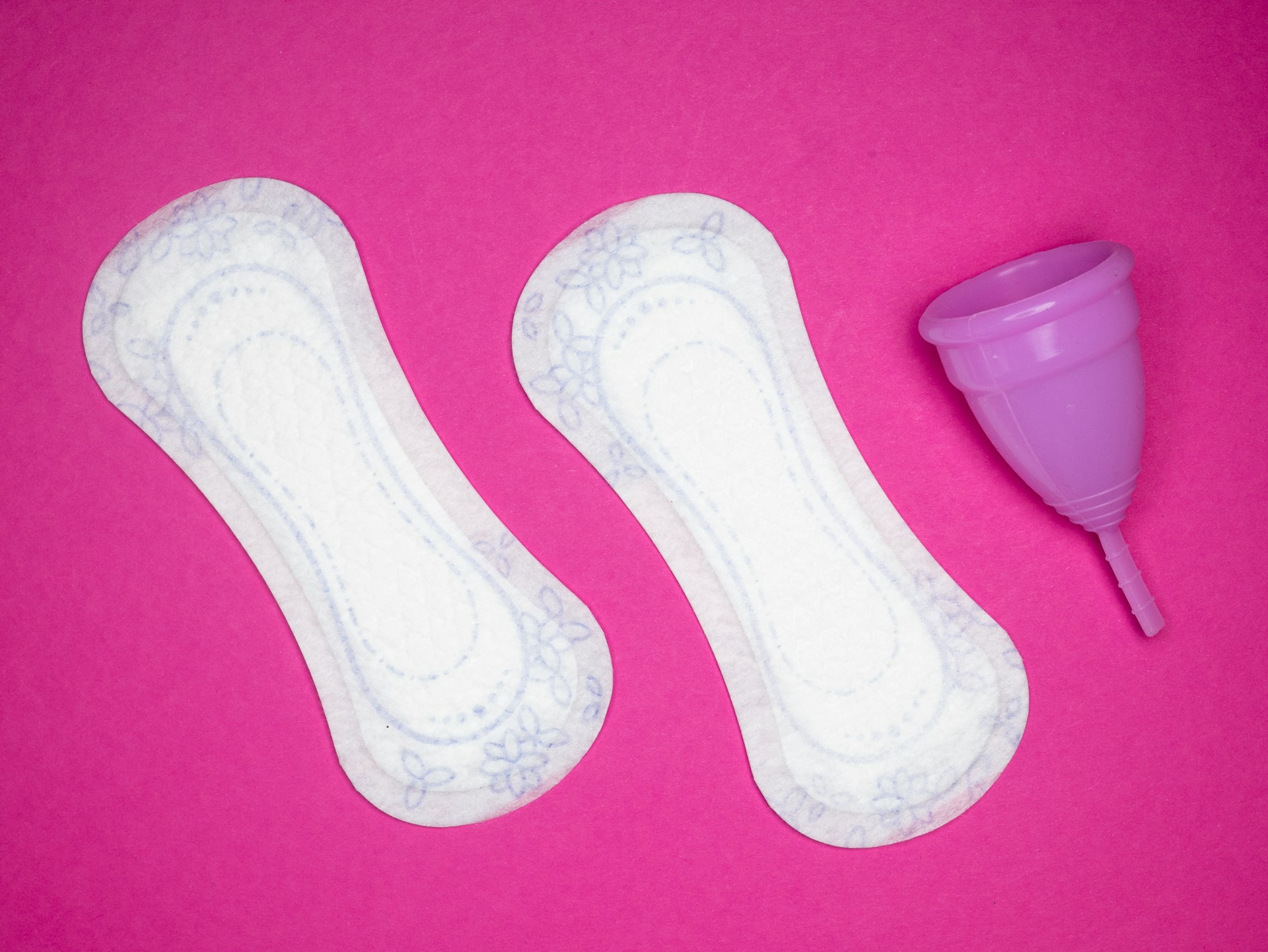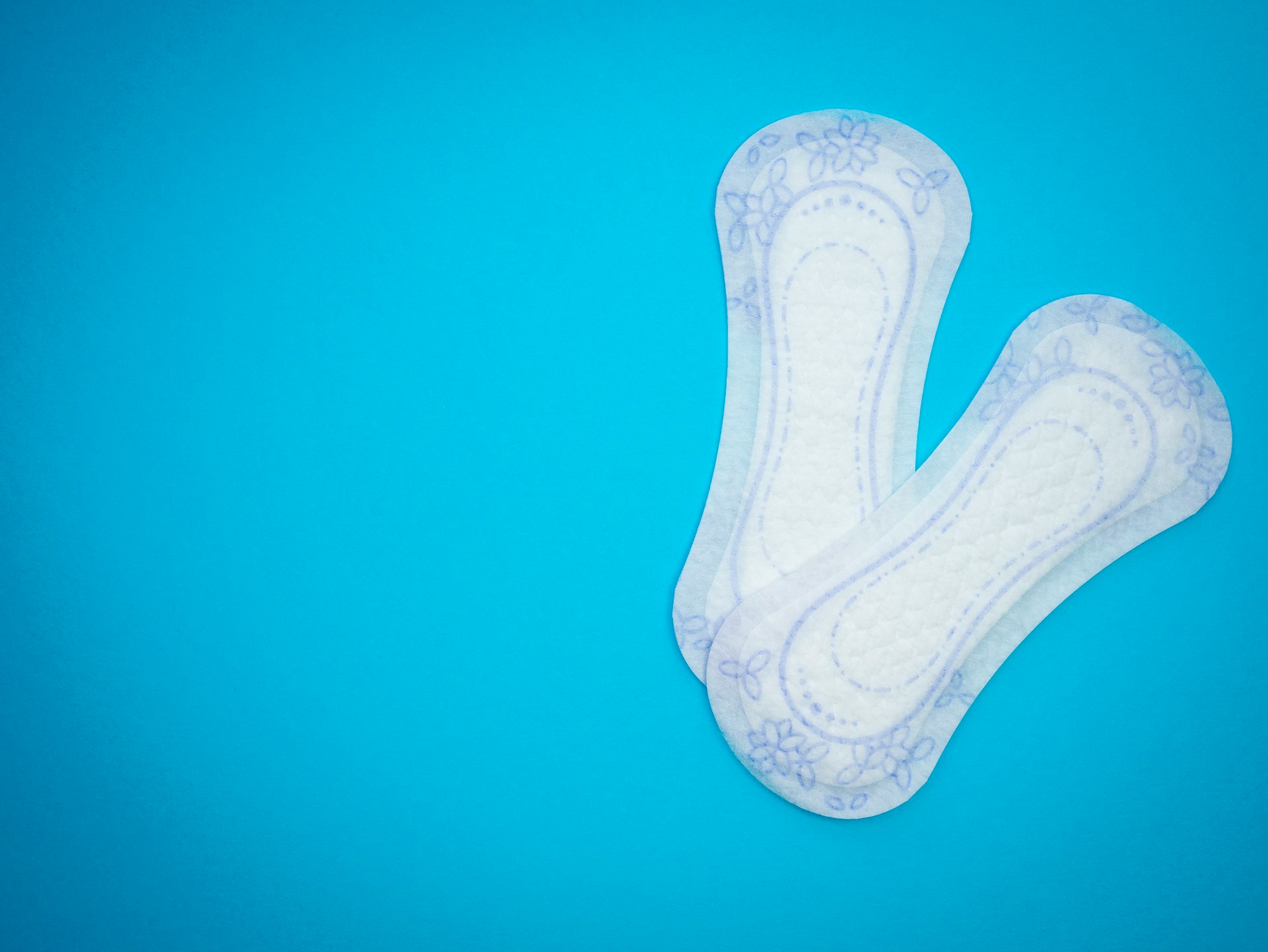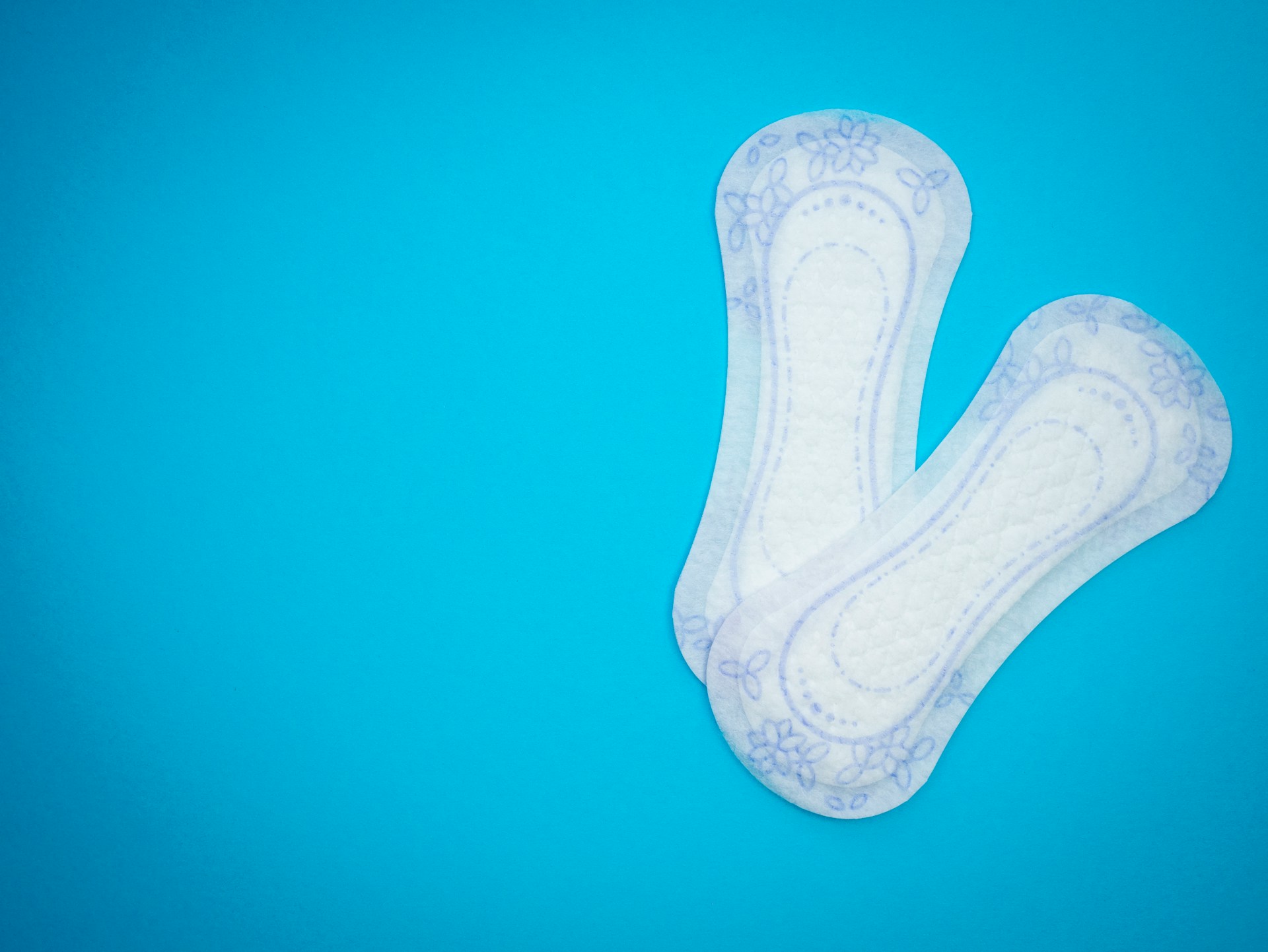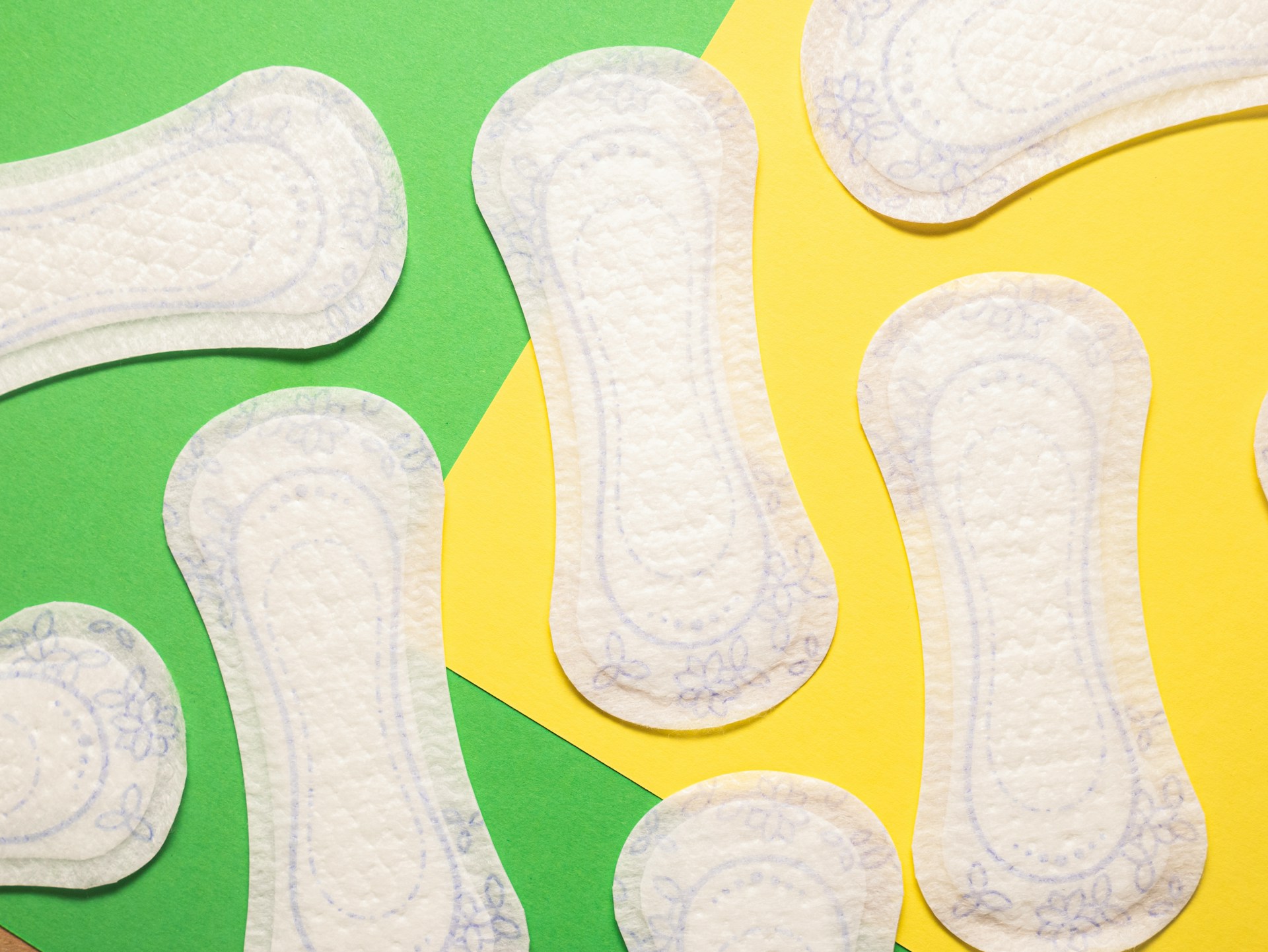Kapanlagi.com - The meaning of menstruation according to primbon is often an interesting topic for some Javanese people. This belief links the time of menstruation with certain signs in a person's life. Although it sounds mystical, many still believe in its meaning to this day.
Some people consider the meaning of menstruation according to primbon as a guide or signal of an impending important event. However, others view it merely as a cultural heritage rich in myths. It is important for you to understand what is fact and what is merely a hereditary belief.
1. Understanding Menstruation and Javanese Primbon

Menstrual pad (credit: unsplash)
Menstruation, or more commonly known as period, is a natural process experienced by women in their reproductive cycle.Medically, menstruation is defined as the shedding of the uterine lining (endometrium) accompanied by bleeding.This process occurs periodically, generally every month, as part of the woman's body's preparation for potential pregnancy.
On the other hand, Javanese Primbon is a collection of traditional records containing various kinds of knowledge and beliefs of the Javanese people.This Primbon encompasses various aspects of life, from fortune-telling, guidance in daily activities, to the interpretation of natural signs.One aspect discussed in the Javanese Primbon is the meaning or significance of the timing of a woman's menstruation.
In the context of the Javanese Primbon, menstruation is not only viewed as a biological process but is also considered to have spiritual significance and can provide clues about the fate or events that the woman will experience.Interpretations are based on various factors such as the day, date, time, and even the month of menstruation.
Although the interpretations of menstruation in Javanese Primbon do not have a scientific basis, they are still held by some members of society as part of cultural heritage.It is important to understand that this perspective is more of a traditional belief and should not replace modern medical understanding of women's reproductive health.
2. History of Beliefs About the Meaning of Menstruation in Javanese Primbon
The belief about the meaning of menstruation in Javanese Primbon has a long and complex historical root. This tradition developed as part of the efforts of ancient Javanese society to understand and interpret various natural phenomena, including biological processes such as menstruation. This history is closely related to the development of culture and belief systems of the Javanese people over time.
In ancient times, when scientific knowledge about reproductive biology was still very limited, the Javanese people, like many other cultures around the world, sought explanations and meanings behind natural events. Menstruation, as a phenomenon experienced only by women and occurring periodically, certainly attracted attention and gave rise to various interpretations.
Javanese Primbon, which initially was a collection of knowledge passed down orally from generation to generation, began to be documented around the 16th or 17th century. During this time, the influence of various beliefs, including animism, Hinduism, Buddhism, and later Islam, has colored the Javanese people's worldview of nature and life.
In this context, the interpretation of the meaning of menstruation may initially be related to animistic beliefs that consider every natural occurrence to have spiritual significance. Over time, this interpretation blended with elements from various other belief systems, forming a complex and unique system of interpretation.
It is important to note that interpretations of the meaning of menstruation in Javanese Primbon are not always consistent and can vary from one region to another in Java. This indicates that this belief is not a rigid system but rather evolves and adapts according to local contexts and changes over time.
Although many Javanese people today no longer fully believe in the Primbon interpretations of the meaning of menstruation, this knowledge is still preserved as part of cultural heritage. For some people, this interpretation is still considered a spiritual guide or at least material for reflection in living life.
In a modern context, understanding the history of this belief is important to appreciate the cultural richness of Java, while still maintaining a critical attitude and prioritizing scientific understanding of reproductive health. This allows us to bridge the respect for tradition and the need for a more evidence-based approach to managing health.
3. Meaning of Menstruation Based on Days

Menstrual pad (credit: unsplash)
In Javanese Primbon, the day when menstruation starts is believed to have a certain meaning or sign for a woman's life. Although this interpretation varies and lacks scientific basis, some people still consider it part of cultural heritage. Here are the general interpretations of the meaning of menstruation based on the day:
- Monday: Believed to be a sign of incoming luck or fortune. This day is considered to bring positive energy and the possibility of improvement in financial or career aspects.
- Tuesday: Believed to be a sign of happiness or good news coming soon. This day is associated with feelings of joy and the possibility of receiving pleasant news.
- Wednesday: Its interpretation tends to be less positive, seen as a sign of potential disputes or conflicts. Women who menstruate on this day are advised to be more cautious in interacting with others.
- Thursday: Considered a sign of impending misfortune or sad news. Although this interpretation sounds negative, some versions of Primbon suggest it serves as a reminder to always be vigilant and careful.
- Friday: Believed to bring luck and happiness. Today is considered a good day and brings positive energy in various aspects of life.
- Saturday: Believed to be a sign of unexpected or surprising events. This interpretation can be positive or negative, depending on the context and individual situation.
- Sunday: Considered a sign of a meeting with an old acquaintance or someone not seen for a long time. This day is associated with nostalgia and the possibility of renewing long-broken relationships.
It is important to remember that these interpretations are part of tradition and belief, not scientific facts. In a modern context, medical understanding of the menstrual cycle is more relevant for women's health and well-being. A regular menstrual cycle, regardless of the day it occurs, is a good indicator of reproductive health.
For those who still appreciate this cultural aspect, Primbon interpretations can be seen as a means of self-reflection or as a reminder to always stay positive and vigilant in daily life. However, it is important not to rely too heavily on these interpretations when making important decisions or assessing health conditions.
In practice, many modern women choose to balance appreciation for cultural heritage with scientific understanding. They may be aware of these traditional interpretations but prioritize routine health check-ups and consultations with medical professionals to monitor their reproductive health.
4. Meaning of Menstruation Based on Dates
In Javanese Primbon tradition, the date on which menstruation begins is also considered to have certain meanings or signs. Although these interpretations vary and lack scientific basis, some people still regard them as part of cultural heritage. Here are the general interpretations of the meaning of menstruation based on the date:
- Dates 1-5: This period is generally considered to bring good signs. The 1st is often associated with happiness, the 2nd with challenges that can be overcome, the 3rd with new opportunities, the 4th with fortune, and the 5th with positive changes.
- Dates 6-10: Interpretations for this period vary. The 6th is often linked to news from afar, the 7th with pleasant surprises, the 8th with invitations or new opportunities, the 9th with relief from problems, and the 10th with important communication.
- Dates 11-15: This mid-month period has diverse meanings. The 11th is often associated with enjoyment, the 12th with self-reflection, the 13th with releasing burdens, the 14th with important meetings, and the 15th with revelations or new understandings.
- Dates 16-20: Interpretations for this period tend to be more challenging. The 16th is linked to vigilance, the 17th with recognition or praise, the 18th with obstacles that need to be overcome, the 19th with the need to be cautious of slander, and the 20th with potential conflicts that should be avoided.
- Dates 21-25: This period has a mix of positive and negative interpretations. Date 21 is often associated with turmoil, date 22 with joy, date 23 with learning from experience, date 24 with unexpected luck, and date 25 with financial opportunities.
- Date 26-31: The end of this month is generally considered to bring positive energy. Date 26 is associated with recognition, date 27 with relief, date 28 with introspection, date 29 with new adventures, date 30 with achievements, and date 31 (if any) with new hopes.
It is important to remember that these interpretations are part of tradition and belief, not scientific facts. In the context of modern health, what is more important is the regularity of the menstrual cycle and overall reproductive health, not specific dates of menstruation onset.
For those who still value this cultural aspect, Primbon interpretations can be seen as a means for self-reflection or as a reminder to always maintain a positive attitude and be vigilant in daily life. However, it is important not to rely too heavily on these interpretations when making important decisions or assessing health conditions.
In modern practice, many women choose to balance appreciation for cultural heritage with scientific understanding. They may be aware of these traditional interpretations but prioritize regular health check-ups and consultations with medical professionals to monitor their reproductive health.
Furthermore, understanding the menstrual cycle from a medical perspective is far more important for women's health and well-being. A regular cycle, regardless of specific dates, is a good indicator of reproductive health. If there are irregularities or other menstrual-related issues, consulting a doctor or reproductive health specialist is the right step to take.
5. Meaning of Menstruation Based on Hours
In the Javanese Primbon tradition, even the time when menstruation begins is considered to have a certain meaning or sign. Although this interpretation is very specific and lacks scientific basis, some people still regard it as part of cultural heritage. Here are general interpretations of the meaning of menstruation based on the time:
- 12:00 AM - 3:59 AM: This early morning period is often associated with reflection and change. For example, menstruation that begins at 1:00 AM is considered a sign of meeting someone from the past, while 3:00 AM is associated with promises that will be fulfilled.
- 4:00 AM - 7:59 AM: This morning time is linked to new beginnings and energy. Menstruation that starts at 5:00 AM may be interpreted as a warning to be cautious of embarrassment, while 7:00 AM is thought to bring pleasant news.
- 8:00 AM - 11:59 AM: This period from morning to noon is often associated with activity and social interaction. For instance, menstruation that begins at 9:00 AM might be seen as a sign of a romantic appointment, while 11:00 AM is linked to loyalty.
- 12:00 PM - 3:59 PM: This time from noon to afternoon is associated with productivity and realization. Menstruation that starts at 1:00 PM may be interpreted as a sign of resilience against disappointment, while 3:00 PM is linked to receiving something from a loved one.
- 4:00 PM - 7:59 PM: This period from afternoon to evening is often regarded as a time of transition and introspection. For example, menstruation that starts at 17:00 may be considered a sign of love beginning to grow, while 19:00 is associated with deep disappointment.
- 20:00 - 23:59: This evening time is linked with reflection and hope. Menstruation that begins at 21:00 may be interpreted as a sign of longing for someone, while 23:00 is associated with loyalty.
It is important to remember that these interpretations are part of tradition and belief, not scientific facts. In the context of modern health, the specific time of the onset of menstruation does not have medical significance. What is more important is the regularity of the menstrual cycle as a whole and reproductive health.
For those who still appreciate this cultural aspect, the interpretations from Primbon can be seen as a means for self-reflection or as a reminder to always maintain a positive outlook and be vigilant in daily life. However, it is crucial not to rely too heavily on these interpretations when making important decisions or assessing health conditions.
In modern practice, many women choose to balance appreciation for cultural heritage with scientific understanding. They may be aware of these traditional interpretations but prioritize regular health check-ups and consultations with medical professionals to monitor their reproductive health.
From a medical perspective, what is more important to pay attention to are the symptoms accompanying menstruation, such as pain, duration, and volume of bleeding, rather than the specific time of onset. If there are concerns about the menstrual cycle or accompanying symptoms, consulting a doctor or reproductive health specialist is the appropriate step to take.
6. Meaning of Menstruation Based on Months

Menstrual pad (credit: unsplash)
In Javanese Primbon tradition, the month in which menstruation occurs is also considered to have certain meanings or signs. Although these interpretations vary and lack scientific basis, some people still regard them as part of cultural heritage. Here are common interpretations of the meaning of menstruation based on the month:
- January: This month is often associated with new beginnings and hope. Menstruation that occurs in January may be interpreted as a sign of upcoming happiness or success in new endeavors.
- February: A month associated with love and affection. Menstruation in this month may be seen as a sign of positive developments in personal or romantic relationships.
- March: A month often linked with change and growth. Menstruation in March may be interpreted as a sign of new opportunities or personal transformation.
- April: A month associated with rebirth and renewal. Menstruation in this month may be regarded as a sign of new inspiration or creative ideas.
- May: A month often associated with prosperity and fertility. Menstruation in May may be interpreted as a sign of an increase in financial or career aspects.
- June: A month associated with balance and harmony. Menstruation in this month may be seen as a sign of the need to maintain balance in various aspects of life.
- July: A month often linked with freedom and adventure. Menstruation in July may be interpreted as a sign of upcoming travel or exciting new experiences.
- August: A month associated with harvest and abundance. Menstruation in this month may be viewed as a sign of the results coming from hard work that has been done.
- September: A month often connected with learning and personal development. Menstruation in September may be interpreted as a sign of the need to focus on education or skill enhancement.
- October: A month associated with change and transformation. Menstruation in this month may be seen as a sign of significant changes in life.
- November: A month often linked with introspection and contemplation. Menstruation in November may be interpreted as a sign of the need for self-evaluation and setting new goals.
- December: A month associated with celebration and completion. Menstruation this month may be considered a sign of an important achievement or a positive year-end.
It is important to remember that this interpretation is part of tradition and belief, not scientific fact. In the context of modern health, the month of menstruation does not have any specific medical significance. What is more important is the regularity of the menstrual cycle as a whole and reproductive health.
For those who still value this cultural aspect, the Primbon interpretation can be seen as a means for self-reflection or as a reminder to always maintain a positive attitude and be vigilant in daily life. However, it is important not to rely too heavily on this interpretation when making important decisions or assessing health conditions.
In modern practice, many women choose to balance appreciation for cultural heritage with scientific understanding. They may be aware of these traditional interpretations but prioritize regular health check-ups and consultations with medical professionals to monitor their reproductive health.
From a medical perspective, what is more important to observe is the consistency of the menstrual cycle from month to month, rather than the specific month of menstruation. If there are significant changes in menstrual patterns or disturbing symptoms, consulting a doctor or reproductive health specialist is the appropriate step to take.
7. Meaning of Menstruation Based on Javanese Market Days
In Javanese tradition, in addition to the Gregorian calendar, there is also a system of dating based on market days. This system consists of five days that repeat cyclically: Kliwon, Legi, Pahing, Pon, and Wage. In the context of Javanese Primbon, the market day on which menstruation begins is also considered to have certain meanings or signs. Here is a general interpretation of the meaning of menstruation based on Javanese market days:
- Kliwon: This day is often associated with spiritual strength and wisdom. Menstruation that begins on Kliwon may be interpreted as a sign of impending enlightenment or new understanding about something important in life. Some believe that this could also be a sign of communication with the spiritual realm.
- Legi: This day is linked to sweetness and happiness. Menstruation that begins on Legi is often seen as a sign of good news or a pleasant event. This can also be interpreted as a good period to start new relationships or strengthen existing bonds.
- Pahing: Today is associated with intelligence and creativity. A period that begins on Pahing may be interpreted as a sign of the emergence of new ideas or creative solutions to problems being faced. Some also believe that this could be a good time to start new projects.
- Pon: Today is often linked to strength and courage. A period that begins on Pon may be seen as a sign of upcoming challenges that require determination to face. However, this can also be interpreted as a time when one will discover inner strength that was previously unrecognized.
- Wage: Today is associated with balance and harmony. A period that begins on Wage is often interpreted as a sign of the need to maintain balance in various aspects of life. This can also be considered a good time for introspection and mending relationships that may be experiencing tension.
It is important to remember that these interpretations are part of tradition and belief, not scientific facts. In the context of modern health, the market day of menstruation has no medical significance. What is more important is the regularity of the menstrual cycle as a whole and reproductive health.
For those who still appreciate this cultural aspect, the interpretation of Primbon can be seen as a means for self-reflection or as a reminder to always maintain a positive attitude and be vigilant in daily life. However, it is important not to rely too heavily on these interpretations when making important decisions or assessing health conditions.
In modern practice, many Javanese women choose to balance their appreciation for cultural heritage with scientific understanding. They may be aware of these traditional interpretations but prioritize regular health check-ups and consultations with medical professionals to monitor their reproductive health.
From a medical perspective, what is more important to note is the consistency of the menstrual cycle and the accompanying symptoms, rather than the specific market day of menstruation. If there are concerns about the menstrual cycle or accompanying symptoms, consulting with a doctor or reproductive health specialist is the appropriate step to take.
8. Islamic Views on Menstruation
In Islamic teachings, menstruation or haid is viewed as a natural process experienced by women and holds specific significance in Islamic law. Here are some important aspects of the Islamic perspective on menstruation:
- Definition of Menstruation in Islam: Menstruation is defined as blood that naturally flows from a woman's womb, not due to illness or injury. In Islamic jurisprudence, menstruation is considered a sign of a woman's maturity and marks the beginning of certain religious obligations.
- Duration of Menstruation: According to the majority of scholars, the minimum duration of menstruation is one day and night (24 hours) and the maximum is 15 days. However, there are differing opinions among the schools of jurisprudence regarding this matter.
- Prohibitions During Menstruation: During the menstruation period, there are several acts of worship and activities that women are not allowed to perform, including:
- Obligatory and voluntary prayers
- Fasting (must be made up on other days)
- Reading and touching the Qur'an (according to some scholars)
- Entering mosques (according to some scholars)
- Engaging in intimate relations
- Tawaf at the Ka'bah
- Purification After Menstruation: After menstruation ends, women are required to perform a mandatory bath (ghusl) before returning to the acts of worship that were previously prohibited.
- Menstruation and Ramadan Fasting: Women who are menstruating are prohibited from fasting during Ramadan, but they are required to make up the fast on other days after Ramadan.
- Menstruation and Divorce: In Islam, divorcing a wife who is menstruating is considered thalaq bid'ah (a divorce that is not in accordance with Islamic law) and is highly discouraged.
- Istihadhah: Islam distinguishes between menstrual blood and istihadhah (abnormal bleeding). Women experiencing istihadhah are still required to perform acts of worship such as prayers and fasting.
- Menstruation and Purity: Although women who are menstruating are considered in a state of impurity for certain acts of worship, Islam emphasizes that this does not diminish the value or dignity of a woman.
- Education about Menstruation: Islam encourages knowledge about menstruation and its laws to be taught to Muslim women from an early age to prepare them for this phase.
- Attitude Towards Menstruating Women: Prophet Muhammad (peace be upon him) taught to treat menstruating women well and not to ostracize them. He himself continued to interact with his wife during her menstruation, only restricting intimate relations.
The Islamic view of menstruation reflects a balance between recognizing the natural processes of a woman's body and the rules of worship. Islam sees menstruation not as something "dirty" or degrading, but as a normal part of a woman's life that has specific legal and spiritual implications.
It is important to note that although there are certain rules related to menstruation, Islam also emphasizes flexibility in their application. For example, if a woman has difficulty determining her menstrual period due to irregular cycles, she is advised to consult with religious scholars and medical experts for appropriate guidance.
In a modern context, many scholars and Muslim intellectuals encourage a more holistic understanding of menstruation, combining medical knowledge with fiqh understanding. This helps Muslim women to better understand their own bodies while still adhering to their religious principles.
9. Medical Perspectives on the Menstrual Cycle

Menstrual pad (credit: unsplash)
From a medical perspective, the menstrual cycle is a complex biological process involving the interaction of hormones and the female reproductive organs. Scientific understanding of this cycle is crucial for women's reproductive health. Here are some key aspects from a medical perspective on the menstrual cycle:
- Definition of the Menstrual Cycle: The menstrual cycle is defined as the interval of time from the first day of one menstrual period to the first day of the next period. The average cycle lasts about 28 days, but it can vary between 21 and 35 days and still be considered normal.
- Phases of the Menstrual Cycle: The menstrual cycle consists of several main phases:
- Menstrual Phase: Shedding of the endometrial lining, usually lasting 3-7 days.
- Follicular Phase: Development of follicles in the ovaries, lasting from the end of menstruation to ovulation.
- Ovulatory Phase: Release of a mature egg from the ovary, usually occurring around day 14 in a 28-day cycle.
- Luteal Phase: Preparation of the endometrium for implantation, lasting from ovulation until the start of the next menstruation if fertilization does not occur.
- Role of Hormones: The menstrual cycle is regulated by the complex interaction of various hormones, including:
- Estrogen: Plays a role in the growth and thickening of the endometrium.
- Progesterone: Prepares the endometrium for implantation and maintains pregnancy if it occurs.
- Follicle Stimulating Hormone (FSH): Stimulates the development of follicles in the ovaries.
- Luteinizing Hormone (LH): Triggers ovulation.
- Normal Variation: It is important to understand that variation in the menstrual cycle is normal. Factors such as age, stress, weight changes, excessive exercise, and certain health conditions can affect the regularity of the cycle.
- Menstrual Cycle Disorders: Several medical conditions can affect the menstrual cycle, including:
- Polycystic Ovary Syndrome (PCOS)
- Endometriosis
- Uterine fibroids
- Thyroid disorders
- Eating disorders
- Cycle Monitoring: Doctors often recommend that women monitor their menstrual cycles. This can help in:
- Detecting irregularities that may require medical evaluation
- Planning for pregnancy or contraception
- Understanding symptom patterns that may be related to the cycle
- Age and the Menstrual Cycle: The menstrual cycle can change throughout a woman's life:
- Menarche (first menstruation): Usually occurs between the ages of 10-15
- Reproductive age: Cycles tend to be more regular
- Perimenopause: Cycles may become irregular as menopause approaches
- Menopause: Cessation of menstrual cycles, usually occurring around ages 45-55
- Menstruation-Related Symptoms: Some women may experience symptoms related to the menstrual cycle, such as:
- Premenstrual Syndrome (PMS): Physical and emotional symptoms that occur before menstruation
- Dysmenorrhea: Menstrual pain that can disrupt daily activities
- Mood changes
- Water retention and swelling
- Lifestyle Influences: Lifestyle factors can affect the menstrual cycle, including:
- Diet and nutrition
- Physical activity levels
- Stress
- Sleep quality
- Contraception and the Menstrual Cycle: Some contraceptive methods can affect the menstrual cycle, such as birth control pills that can regulate the cycle or even stop menstruation altogether.
Medical understanding of the menstrual cycle continues to evolve with new research. Modern approaches to menstrual health emphasize the importance of education, self-monitoring, and regular medical consultations to ensure optimal reproductive health.
It is important for women to understand their own menstrual cycles and recognize what is normal for their bodies. Significant changes in menstrual patterns or disturbing symptoms should be consulted with a health professional for further evaluation.
10. Myths and Facts About Menstruation
Regarding menstruation or periods, there are many myths circulating in society. Some of these myths have been around for a long time and are still believed by some people, even though they lack scientific basis. It is important to distinguish between myths and facts to ensure a correct understanding of reproductive health. Here are some common myths about menstruation along with their scientific facts:
Myth 1: Women Who Are Menstruating Should Not Wash Their Hair
Fact: There is no medical reason that prohibits women from washing their hair during menstruation. In fact, maintaining cleanliness during menstruation is very important for health and comfort. Washing hair will not affect menstrual blood flow or cause any health problems.
Myth 2: Exercising During Menstruation Is Dangerous
Fact: Light to moderate exercise during menstruation can actually help reduce cramps and improve mood. However, the intensity of exercise can be adjusted according to each individual's body condition. If you feel uncomfortable, resting is a good option.
Myth 3: Women Cannot Get Pregnant During Menstruation
Fact: Although the chances are low, pregnancy can still occur if having sexual intercourse during menstruation, especially in women with short or irregular cycles. Sperm can survive in a woman's body for up to 5 days, so if ovulation occurs soon after menstruation, fertilization may still happen.
Myth 4: Irregular Menstruation Always Indicates Serious Health Problems
Fact: Menstrual cycles can vary and are influenced by many factors such as stress, weight changes, or excessive exercise. Mild irregularities do not always indicate serious health issues. However, if irregularities persist for a long time or are accompanied by other disturbing symptoms, consulting a doctor is necessary.
Myth 5: Women Living Together Will Experience Menstrual Cycle Synchronization
Fact: Although this idea is popular, scientific research has not found strong evidence supporting the theory of menstrual cycle synchronization. Similar timing of menstruation among women living together is more likely to occur by chance due to normal variations in menstrual cycles.
Myth 6: Eating Certain Foods Can Speed Up or Slow Down Menstruation
Fact: There is no scientific evidence showing that certain foods can directly speed up or slow down menstruation. However, a balanced diet and healthy lifestyle can help maintain regularity in menstrual cycles.
Myth 7: The First Menstrual Period Determines Lifelong Cycle Patterns
Fact: Menstrual cycles can change throughout a woman's life, influenced by various factors including age, lifestyle, and health conditions. The menstrual pattern at the onset of puberty does not always reflect the pattern that will be experienced in adulthood.
Myth 8: Using Tampons Can Cause Loss of Virginity
Fact: Using tampons does not cause loss of virginity. Virginity is related to the integrity of the hymen, which can have different shapes and elasticity in each woman. Tampons, when used correctly, will not damage the hymen.
Myth 9: Women Should Not Bathe or Soak During Menstruation
Fact: Bathing or soaking during menstruation is not harmful and can actually help relieve cramps and make the body more comfortable. Water will not enter the vagina and disrupt menstrual blood flow.
Myth 10: Heavy Menstruation Indicates Good Health
Fact: The normal volume of menstrual blood varies among women. Very heavy menstruation (menorrhagia) can be a sign of a medical condition that requires attention, such as fibroids or hormonal disorders.
Understanding the facts behind these myths is important for women's health and well-being. Proper education about menstruation can help women manage their reproductive health better and reduce stigma or misunderstandings surrounding menstruation. If there are any doubts or concerns about the menstrual cycle, it is always advisable to consult a healthcare professional for accurate information and management.
11. Self-Care Tips During Menstruation

Menstrual pad (credit: unsplash)
Proper self-care during menstruation is very important for the comfort and health of women. Here are some self-care tips that can help manage symptoms and improve well-being during menstruation:
1. Maintain Hygiene
Hygiene is a crucial aspect during menstruation. Change pads, tampons, or menstrual cups regularly to prevent infections and unpleasant odors. Gently clean the genital area using warm water and mild soap. Avoid using harsh vaginal cleansers as they can disrupt the natural pH balance.
2. Choose the Right Menstrual Products
Choose menstrual products that suit your needs and comfort. Options include pads, tampons, menstrual cups, or period underwear. Be sure to change products according to the usage instructions to avoid the risk of Toxic Shock Syndrome (TSS) and other infections.
3. Pain Management
To address menstrual cramps, here are some methods to try:
- Warm compress on the lower abdomen or back
- Light exercise such as walking or yoga
- Relaxation techniques such as meditation or deep breathing
- Take pain relievers such as ibuprofen or paracetamol if needed (consult with a doctor first)
4. Proper Nutrition
Consume a balanced and nutrient-rich diet. Increase intake of:
- Iron-rich foods to replace what is lost during menstruation
- Fruits and vegetables for vitamins and minerals
- Calcium-rich foods to help reduce cramps
- Protein to help stabilize blood sugar and mood
Avoid excessive consumption of caffeine, salt, and processed foods that can worsen water retention and bloating.
5. Adequate Hydration
Drink enough water to help reduce bloating and increase energy. Water also helps prevent dehydration, which can worsen symptoms like headaches.
6. Adequate Rest
Make sure to get enough quality sleep. Good rest can help reduce fatigue and improve mood, which often fluctuates during menstruation.
7.Light Exercise
Although it may feel difficult, light exercises such as walking, swimming, or yoga can help improve circulation and reduce cramps. Exercise also releases endorphins that can enhance mood.
8.Stress Management
Stress can worsen PMS symptoms and discomfort during menstruation. Practice stress management techniques such as meditation, yoga, or calming hobbies to help manage emotions and anxiety.
9.Comfortable Clothing
Choose loose and comfortable clothing, especially around the abdominal area. Avoid tight clothing that can add to discomfort or irritation.
10.Cycle Monitoring
Note the start and end dates of menstruation, as well as the symptoms experienced. This can help you understand cycle patterns and anticipate mood changes or physical symptoms.
11.Skin Care
Some women may experience skin issues such as acne during menstruation. Maintain facial cleanliness and use skincare products suitable for your skin type.
12.Avoid Alcohol and Cigarettes
Alcohol and cigarettes can worsen PMS and menstruation symptoms. Avoid or reduce consumption during this period.
13. Consider Supplements
Some supplements like calcium, magnesium, or vitamin B6 may help reduce PMS symptoms. However, always consult with a doctor before starting any supplements.
14.Heat Therapy
In addition to warm compresses, soaking in warm water can also help relieve cramps and muscle tension.
15.Communication
Don’t hesitate to communicate with family, friends, or partners about how you’re feeling. Emotional support can be very helpful during this time.
Remember that every woman has a different menstruation experience. What works for one person may not be as effective for another. It’s important to find the self-care combination that best suits your needs. If menstrual symptoms are very disruptive or you experience significant changes in your menstrual pattern, it is always advisable to consult a healthcare professional.
12. When to Consult a Doctor
Although menstruation is a natural process, there are situations where consulting a doctor is highly recommended. Understanding when to seek medical help is important for maintaining reproductive health. Here are some conditions that indicate the need for a consultation with a doctor:
1.Significant Changes in Menstrual Patterns
If you experience drastic changes in your menstrual cycle, such as a cycle that becomes very irregular, shorter (less than 21 days), or longer (more than 35 days), this could be a sign of hormonal issues or other medical conditions that require evaluation.
2.Very Heavy Bleeding
Very heavy menstruation (menorrhagia) where you need to change pads or tampons every one or two hours, or menstruation that lasts more than 7 days, could be a sign of conditions such as fibroids, polyps, or blood clotting disorders.
3.Severe Pain
Menstrual pain that is extremely severe and disrupts daily activities, especially if accompanied by other symptoms such as nausea or vomiting, could indicate endometriosis or other conditions that require medical attention.
4.No Menstrual Period
If you have not had a menstrual period for more than 3 months (amenorrhea) and you are sure you are not pregnant, this could be a sign of hormonal problems, eating disorders, or other medical conditions that require evaluation.
5. Bleeding Outside Menstrual Cycle
Bleeding between menstrual periods or after menopause can be a sign of infection, polyps, or in rare cases, cancer. This needs to be evaluated by a doctor.
6.Severe PMS Symptoms
If PMS symptoms are very severe and disrupt daily life, such as severe depression, anxiety, or extreme mood swings, this may indicate Premenstrual Dysphoric Disorder (PMDD) that requires medical treatment.
7.Change in Color or Consistency of Menstrual Blood
Significant changes in color (e.g., very dark or brownish) or consistency of menstrual blood (e.g., very watery or clotted) that are unusual for you can be a sign of infection or other issues that require examination.
8.Toxic Shock Syndrome (TSS) Symptoms
If you are using tampons and experience symptoms such as high fever, a sunburn-like rash, sore throat, nausea, or vomiting, seek medical help immediately as this could be a sign of TSS, a serious and potentially life-threatening condition.
9.Infertility
If you have been trying to conceive for more than a year (or 6 months if you are over 35) without success, consulting a doctor can help identify causes and treatment options.
10.Early Menopause Symptoms
If you experience menopause symptoms such as hot flashes or vaginal dryness before the age of 40, this could be a sign of early menopause that requires evaluation and medical management.
11. Family History with Reproductive Issues
If you have a family history of conditions such as endometriosis, PCOS, or ovarian cancer, discussing risks and preventive screenings with your doctor may be necessary.
12.Suspected Sexually Transmitted Diseases (STDs)
If you experience symptoms such as abnormal discharge, pain during urination, or lesions in the genital area, this could be a sign of STDs that require immediate diagnosis and treatment.
13.Dramatic Weight Changes
Significant weight changes, whether loss or gain, can affect the menstrual cycle and may indicate hormonal or metabolic issues that require medical evaluation.
14.Menstrual-Related Anxiety or Depression
If you experience severe anxiety or depression related to your menstrual cycle, consulting with a doctor or mental health professional can help manage these symptoms.
15.Fertility Issues
If you have questions or concerns about fertility, whether in the context of trying to conceive or preventing pregnancy, discussing with your doctor can provide valuable information and guidance.
It is important to remember that every woman has a unique menstrual experience. What is normal for one person may not be normal for another. If you feel uncertain or worried about any aspect of your menstrual cycle, do not hesitate to consult a healthcare professional. They can provide comprehensive evaluations, answer your questions, and offer appropriate care if needed. Remember that reproductive health is an integral part of your overall health, and seeking medical assistance when necessary is an important step in maintaining your well-being.
13. The Influence of Lifestyle on the Menstrual Cycle

Menstrual pads (credit: unsplash)
Lifestyle has a significant impact on a woman's menstrual cycle. Various factors in daily life can affect the regularity, duration, and intensity of menstruation. Understanding the influence of these lifestyle factors is important for optimal reproductive health management. Here are some lifestyle aspects that can affect the menstrual cycle:
1.Diet
Diet plays a crucial role in menstrual health. Consuming a balanced and nutrient-rich diet can help maintain cycle regularity. Conversely, a poor or overly restrictive diet can disrupt hormonal balance and affect the cycle. Some important points related to diet:
- Deficiencies in certain nutrients such as iron, vitamin D, and omega-3 can lead to cycle irregularities.
- Consuming high-fiber foods can help reduce excess estrogen in the body, which can affect the cycle.
- Foods high in sugar and saturated fats can increase inflammation in the body, potentially affecting the menstrual cycle.
- A vegetarian or vegan diet, if not well-planned, can lead to nutrient deficiencies that affect the cycle.
2. Physical Activity
Exercise and physical activity have a positive impact on overall health, including the menstrual cycle. However, extreme levels of activity can affect the cycle:
- Regular moderate-intensity exercise can help reduce PMS symptoms and maintain cycle regularity.
- Excessive or sustained high-intensity exercise can lead to amenorrhea (absence of menstruation) or oligomenorrhea (infrequent cycles).
- Sudden changes in exercise routines can cause temporary changes in the cycle.
- Physical activity can help reduce stress, which in turn positively impacts the menstrual cycle.
3. Stress Management
Stress has a significant influence on the menstrual cycle. Stress hormones such as cortisol can disrupt the balance of reproductive hormones:
- Chronic stress can lead to cycle irregularities, including cycles that are longer or shorter than usual.
- Acute stress can cause delayed ovulation or even temporarily halt menstruation.
- Stress management techniques such as meditation, yoga, or deep breathing can help maintain cycle regularity.
- Poor sleep quality, often associated with stress, can also affect hormonal cycles.
4. Body Weight
Body weight is closely related to hormonal function and the menstrual cycle:
- Being underweight can cause amenorrhea because the body does not have enough fat to produce the necessary hormones.
- Obesity can lead to excess estrogen production, which can disrupt ovulation and menstruation cycles.
- Significant weight changes, whether loss or gain, can cause cycle irregularities.
- Maintaining a healthy weight can help stabilize the menstrual cycle.
5. Caffeine and Alcohol Consumption
Caffeinated and alcoholic beverages can affect the menstrual cycle:
- Excessive caffeine consumption can increase estrogen levels, potentially affecting the cycle.
- Alcohol can disrupt hormone metabolism in the liver, which can affect hormonal balance.
- Excessive alcohol consumption can increase the risk of cycle irregularities and fertility issues.
- Moderation in caffeine and alcohol consumption is generally recommended for optimal menstrual health.
6. Environmental Exposure
Environmental factors can also affect the menstrual cycle:
- Exposure to endocrine-disrupting chemicals (such as BPA in plastics) can affect hormonal balance.
- Air pollution has been linked to irregularities in the menstrual cycle in several studies.
- Climate change or moving to a new environment can cause temporary changes in the cycle.
- Excessive exposure to artificial light, especially at night, can disrupt circadian rhythms and affect hormonal cycles.
Understanding how lifestyle can influence the menstrual cycle allows women to make more informed choices in maintaining their reproductive health. It is important to remember that every woman is unique, and what affects one person may not have the same effect on another. If you experience significant changes in your menstrual cycle or have concerns, it is always advisable to consult a healthcare professional.
14. The Role of Hormones in the Menstrual Cycle
Hormones play a central role in regulating the menstrual cycle. Understanding how these hormones interact and affect the body is crucial for comprehending women's reproductive health overall. Here is a detailed explanation of the roles of various hormones in the menstrual cycle:
1.Estrogen
Estrogen is the primary hormone involved in the menstrual cycle:
- Produced mainly by the ovaries, with small amounts also produced by the adrenal glands and fat tissue.
- Responsible for the development of secondary sexual characteristics in women.
- Stimulates the growth of the uterine lining (endometrium) during the follicular phase of the cycle.
- Helps in the production of cervical fluid that facilitates sperm movement.
- Plays a role in mood regulation and bone health.
- Increased estrogen levels leading up to ovulation trigger an LH surge that causes the release of the egg.
2.Progesterone
Progesterone is another key hormone in the menstrual cycle:
- Primarily produced by the corpus luteum after ovulation.
- Prepares the endometrium for embryo implantation if fertilization occurs.
- Helps maintain pregnancy if it occurs.
- Lowers estrogen levels, which can lead to PMS symptoms.
- Has a calming effect on the central nervous system.
- A decrease in progesterone at the end of the cycle triggers the onset of menstruation if pregnancy does not occur.
3.Follicle Stimulating Hormone (FSH)
FSH is a hormone produced by the pituitary gland:
- Stimulates the growth of follicles in the ovaries at the beginning of the cycle.
- Triggers the production of estrogen by developing follicles.
- Plays a crucial role in the ovulation process.
- FSH levels rise at the beginning of the cycle and decrease after ovulation.
- Changes in FSH levels can affect the regularity of the cycle and fertility.
4.Luteinizing Hormone (LH)
LH is also produced by the pituitary gland and has a crucial role:
- An LH surge triggers ovulation, releasing a mature egg from the ovary.
- Stimulates the formation of the corpus luteum after ovulation.
- Plays a role in the production of progesterone by the corpus luteum.
- LH levels sharply increase about 24-36 hours before ovulation.
- Measurement of LH levels is often used in ovulation tests.
5. Inhibin
Inhibin is a lesser-known but important hormone in the cycle:
- Produced by developing ovarian follicles.
- Helps regulate FSH production by the pituitary gland.
- Inhibin levels rise before ovulation and decrease afterwards.
- Plays a role in the negative feedback that controls the menstrual cycle.
6.Gonadotropin-Releasing Hormone (GnRH)
GnRH is a hormone produced by the hypothalamus:
- Stimulates the pituitary gland to release FSH and LH.
- Produced in a pulsatile manner, with varying frequency and amplitude throughout the cycle.
- Changes in GnRH release patterns can affect the overall menstrual cycle.
- Important in the regulation of puberty and the onset of menstruation.
The complex interactions between these hormones regulate the menstrual cycle. Imbalances in the production or function of these hormones can lead to various menstrual disorders, including cycle irregularities, amenorrhea, or fertility issues. Understanding the role of these hormones is crucial not only for understanding the normal menstrual cycle but also for diagnosing and treating menstrual-related disorders.
It is important to note that external factors such as stress, diet, exercise, and certain medical conditions can affect the production and balance of these hormones. Therefore, maintaining a healthy lifestyle and consulting with healthcare professionals when there are concerns about the menstrual cycle is an important step in maintaining reproductive health.
15. Common Disorders Related to the Menstrual Cycle
Although menstruation is a natural process, many women experience various disorders related to their menstrual cycle. Understanding these disorders is important for recognizing symptoms and seeking appropriate treatment. Here are some common disorders related to the menstrual cycle:
1. Dysmenorrhea (Menstrual Pain)
Dysmenorrhea is pain or cramps that occur during menstruation:
- It can be divided into primary dysmenorrhea (without an underlying cause) and secondary dysmenorrhea (caused by other medical conditions).
- Symptoms include lower abdominal pain, back pain, nausea, and sometimes diarrhea.
- It can be treated with anti-inflammatory medications, contraceptive pills, or in severe cases, may require further medical intervention.
- Lifestyle changes such as regular exercise and a balanced diet can help reduce symptoms.
2. Premenstrual Syndrome (PMS)
PMS is a collection of physical and emotional symptoms that occur before menstruation:
- Symptoms may include mood swings, bloating, breast pain, fatigue, and changes in appetite.
- It usually starts 1-2 weeks before menstruation and subsides when menstruation begins.
- Management involves a combination of lifestyle changes, nutritional supplements, and sometimes medication.
- In severe cases, it may be diagnosed as Premenstrual Dysphoric Disorder (PMDD), which requires more intensive management.
3. Menorrhagia (Heavy Menstrual Bleeding)
Menorrhagia is very heavy or prolonged menstrual bleeding:
- Characterized by bleeding lasting more than 7 days or blood loss exceeding 80 ml per cycle.
- It can be caused by various factors including fibroids, polyps, or hormonal disorders.
- It can lead to significant anemia and fatigue.
- Treatment depends on the underlying cause and may involve hormonal therapy, surgical procedures, or treatment of the underlying condition.
4. Amenorrhea (Absence of Menstruation)
Amenorrhea is the absence of menstruation:
- Primary amenorrhea: when a girl has not had her first menstruation by age 16.
- Secondary amenorrhea: when menstruation stops for 3 months or more in a woman who previously had regular cycles.
- Causes may include pregnancy, hormonal disorders, stress, excessive exercise, or certain medical conditions.
- Diagnosis and treatment depend on the underlying cause.
5. Polycystic Ovary Syndrome (PCOS)
PCOS is an endocrine disorder that affects many women of reproductive age:
- Characterized by irregular menstruation, ovarian cysts, and increased androgen hormones.
- Can lead to fertility issues, excessive hair growth, and an increased risk of type 2 diabetes.
- Management involves symptom management through lifestyle changes, hormonal treatments, and sometimes surgical intervention.
6.Endometriosis
Endometriosis is a condition where tissue similar to the uterine lining grows outside the uterus:
- Can cause severe menstrual pain, pain during intercourse, and fertility problems.
- Diagnosis is often delayed due to varying symptoms that overlap with other conditions.
- Treatment may involve pain management, hormonal therapy, and in severe cases, surgery.
7.Uterine Fibroids
Fibroids are benign tumors that grow inside or on the walls of the uterus:
- Can cause heavy menstrual bleeding, pain, and pressure on the pelvic organs.
- The size and location of fibroids determine symptoms and treatment options.
- Treatment can range from monitoring to hormonal therapy or surgery.
These disorders can have a significant impact on women's quality of life and, in some cases, may affect fertility. It is important for women to understand their bodies and recognize abnormal changes in their menstrual cycles. Consulting with a healthcare professional is highly recommended if there are concerns or disturbing symptoms.
Additionally, research continues in the field of women's reproductive health, bringing new understanding of these disorders and developing better diagnostic and treatment methods. A holistic approach that considers lifestyle, nutrition, and mental health is increasingly recognized as an important component in managing menstrual disorders.
16. Conclusion

Menstrual pads (credit: unsplash)
Meaning of menstruation according to Javanese primbon is part of a rich and fascinating cultural heritage. Although this interpretation lacks scientific basis, it remains an important part of cultural identity for some communities. It is essential to balance appreciation for tradition with modern scientific understanding of the menstrual cycle.
From a medical perspective, the menstrual cycle is a complex biological process regulated by hormonal interactions and involves various reproductive organs. A good understanding of this cycle is crucial for women's overall reproductive health. Factors such as lifestyle, nutrition, and health conditions can affect the regularity and characteristics of the menstrual cycle.
It is important for women to monitor their menstrual cycles and recognize changes that may require medical attention. Consulting with healthcare professionals is highly recommended if there are concerns or troubling symptoms. A holistic approach to menstrual health, considering physical, emotional, and social aspects, is increasingly recognized as the best way to maintain reproductive well-being.
Finally, ongoing education about menstrual health is very important. This helps to dispel myths and stigma surrounding menstruation, encourages open discussion, and ensures that women have the information they need to make informed decisions about their health. By combining respect for cultural traditions with modern scientific understanding, we can create a more comprehensive and inclusive approach to menstrual health.
Find more interesting reviews at kapanlagi.com. If not now, when?
(kpl/psp)
Disclaimer: This translation from Bahasa Indonesia to English has been generated by Artificial Intelligence.



















